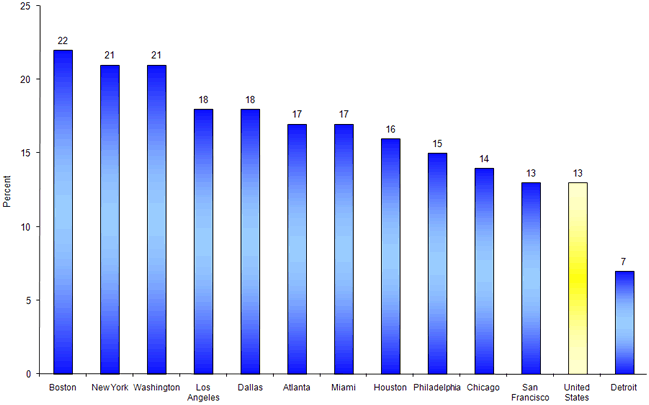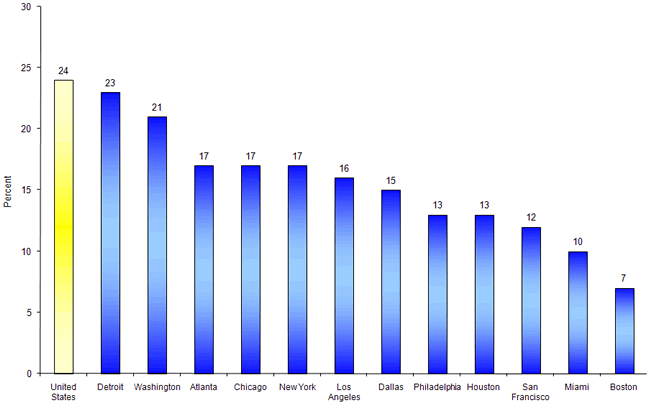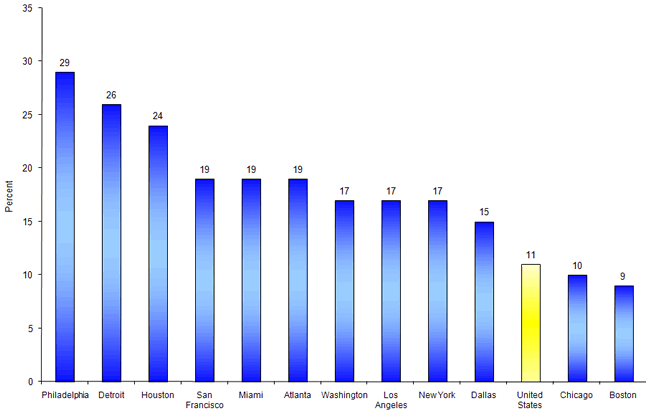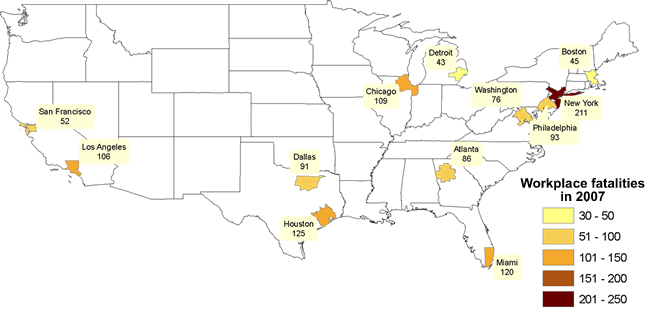| Internet: www.bls.gov/ro3/ | PLS - 4478 FOR RELEASE: WEDNESDAY, NOVEMBER 26, 2008 |
||||||||||||||||||||||||||||||||||||||||||||||||||||||||||||||||||||||||||||
| INFORMATION: | Gerald Perrins (215) 597-3282 |
||||||||||||||||||||||||||||||||||||||||||||||||||||||||||||||||||||||||||||
| MEDIA CONTACT: | Sheila Watkins (215) 861-5600 |
||||||||||||||||||||||||||||||||||||||||||||||||||||||||||||||||||||||||||||
Workplace Fatalities in the Washington, D.C. Area for 2007 (PDF)Fatal work injuries in the Washington-Arlington-Alexandria, D.C.-Va.-Md.-W.Va. Metropolitan Statistical Area (MSA) totaled 76 in 2007, according to the Bureau of Labor Statistics of the U.S. Department of Labor. Sheila Watkins, the Bureau’s regional commissioner, noted that this year’s count was 12 percent higher than the fatalities recorded in 2006. Please note that the 2007 figures are preliminary; final results will be released in April 2009. Most workplace fatalities1 in the Washington, D.C. area in 2007 resulted from falls to a lower level (16), highway crashes (16), and homicides (13), which together accounted for nearly three-fifths of the work-related deaths in the metropolitan area. The Washington, D.C. area had the 9th-highest fatality count among the 12 largest metropolitan areas in the United States, close to its 8th-place ranking in population size. Not unexpectedly, the most populated area in the country, New York, also had the highest number of workplace fatalities (211) in 2007. The three smallest metropolitan areas in this group—San Francisco, Boston, and Detroit—had the three lowest fatality counts (ranging from 43 to 52). (See table A.)
In the Washington, D.C. metropolitan area, falls to a lower level and highway crashes tied as the most frequent type of fatal occupational injury, each accounting for 21 percent of workplace deaths. Almost all of the 12 largest metropolitan areas had a higher-than-average percentage of occupational fatalities resulting from falls to a lower level. Only Detroit, with a 7-percent share, was below the 13 percent registered nationally in 2007, while San Francisco matched the national share.  The Boston metropolitan area had the largest share attributable to falls to a lower level, 22 percent. (See chart A.) Falls to a lower level comprised the most frequent fatal workplace event in Boston, Dallas, Los Angeles, and New York in 2007. Chart A. Falls to a lower level as a percent of fatal occupational injuries for the 12 largest metropolitan areas in 2007
All of the 12 largest areas had a lower percentage of occupational fatalities resulting from highway crashes (officially titled highway incidents) than the national share of 24 percent; only Detroit had a share (23 percent) close to that for the nation. In Washington, workplace deaths attributable to highway crashes accounted for 21 percent of on-the-job fatalities, the second-highest percentage among the 12 largest metropolitan areas. Boston had the lowest percentage attributable to highway crashes with 7 percent. (See chart B.) Nationwide, highway crashes were the most frequent fatal workplace event. The 17-percent share of homicides in Washington was higher than the 11-percent national share.  In three of the areas—Houston, Detroit, and Philadelphia—homicides comprised about one-quarter of all work-related fatalities, more than double the U.S. proportion. At the other end of the spectrum, Boston and Chicago recorded shares of 9 and 10 percent, respectively, close to that for the nation. (See chart C.) Homicides comprised the most frequent fatal occupational injury in Atlanta, Detroit, Houston, Miami, Philadelphia, and San Francisco. Chart B. Highway crashes as a percent of fatal occupational injuries for the 12 largest metropolitan areas in 2007
Chart C. Homicides as a percent of fatal occupational injuries for the 12 largest metropolitan areas in 2007
Additional Census of Fatal Occupational Injuries data are available on the BLS Internet site at www.bls.gov/iif/. Data can be accessed in two ways, through Create Customized Tables, which allows quick access to particular items, or via the special request FTP service, which allows access to an extensive collection of flat text files. For personal assistance or further information on the Census of Fatal Occupational Injuries program, as well as other Bureau programs, contact the Mid-Atlantic Information Office at 215-597-3282 from 8:30 a.m. to 12:00 p.m. and 1:00 p.m. to 3:30 p.m. ET. Information on the Census of Fatal Occupational Injuries and other programs and surveys are available on our Web site at www.bls.gov/ro3/. Technical Note
Background of the programThe Census of Fatal Occupational Injuries, part of the BLS occupational safety and health statistics program, compiles a count of all fatal work injuries occurring in the U.S. in each calendar year. The program uses diverse State, federal, and independent data sources to identify, verify, and describe fatal work injuries. This assures counts are as complete and accurate as possible. For technical information about the CFOI program, please go to the BLS Handbook of Methods on the BLS Web site. To get to that document, click on Workplace Injuries on the BLS home page, scroll down to IIF Documentation, and then click on “BLS Handbook of Methods.� The technical information and definitions for the CFOI Program are in Chapter 9, Part 2 of the BLS Handbook of Methods.
Federal/State agency coverageThe Census of Fatal Occupational Injuries includes data for all fatal work injuries, whether the decedent was working in a job covered by the Occupational Safety and Health Administration (OSHA) or other federal or State agencies or was outside the scope of regulatory coverage. Thus, any comparison between the BLS fatality census counts and those released by other agencies should take into account the different coverage requirements and definitions being used by each agency. Several federal and State agencies have jurisdiction over workplace safety and health. OSHA and affiliated agencies in States with approved safety programs cover the largest portion of the nation's workers. However, injuries and illnesses occurring in certain industries or activities, such as coal, metal, and nonmetal mining and highway, water, rail, and air transportation, are excluded from OSHA coverage because they are covered by other federal agencies, such as the Mine Safety and Health Administration and various agencies within the Department of Transportation.
AcknowledgmentsBLS thanks the District of Columbia Department of Health, Virginia Department of Labor and Industry, Maryland Department of Labor, Licensing and Regulation, and West Virginia Department of Labor for their efforts in collecting accurate, comprehensive, and useful data on fatal work injuries. BLS also appreciates the efforts of all federal, State, local, and private sector entities that submitted source documents used to identify fatal work injuries. Among these agencies are the Occupational Safety and Health Administration; the National Transportation Safety Board; the U.S. Coast Guard; the Mine Safety and Health Administration; the Employment Standards Administration (Federal Employees' Compensation and Longshore and Harbor Workers' divisions); the Federal Railroad Administration; the Department of Energy; State vital statistics registrars, coroners, and medical examiners; State departments of health, labor and industries, and workers' compensation agencies; State and local police departments; and State farm bureaus. The Washington-Arlington-Alexandria, D.C.-Va.-Md.-W.Va. Metropolitan Statistical Area (MSA) consists of the Bethesda-Frederick-Gaithersburg, Md. Metropolitan Division (MD) and the Washington-Arlington-Alexandria, D.C.-Va.-Md.-W.Va. Metropolitan Division (MD).
1 Fatal events are categorized into several major groupings including transportation incidents, assaults and violent acts, and falls. These major groups are further broken down into more detailed groups. See the Occupational Injury & Illness Classification System (OIICS) Manual on our Web site at www.bls.gov/iif/oshoiics.htm for detailed information on the categories of fatalities used in this survey.Â
|
|||||||||||||||||||||||||||||||||||||||||||||||||||||||||||||||||||||||||||||
| Event or exposure(2) | Total fatalities (number) | Goods producing | Service providing | ||||||||||
|---|---|---|---|---|---|---|---|---|---|---|---|---|---|
| Total goods producing | Natural resources and mining(3) | Construction | Manufacturing | Total service providing | Trade, transportation, and utilities | Information | Financial activities | Professional and business services | Education and health services | Leisure and hospitality | Other services | ||
Total |
76 | 18 | -- | 18 | -- | 46 | 26 | -- | 3 | 11 | -- | -- | 3 |
Contact with objects and equipment |
6 | -- | -- | -- | -- | 5 | 3 | -- | -- | -- | -- | -- | -- |
Struck by object or equipment |
6 | -- | -- | -- | -- | 5 | 3 | -- | -- | -- | -- | -- | -- |
Struck by falling object or equipment |
5 | -- | -- | -- | -- | 4 | 3 | -- | -- | -- | -- | -- | -- |
Falls |
18 | 8 | -- | 8 | -- | 7 | -- | -- | -- | 4 | -- | -- | -- |
Fall to lower level |
16 | 8 | -- | 8 | -- | 6 | -- | -- | -- | 4 | -- | -- | -- |
Fall to lower level, nec |
6 | -- | -- | -- | -- | 4 | -- | -- | -- | 3 | -- | -- | -- |
Exposure to harmful substances or environments |
6 | 4 | -- | 4 | -- | -- | -- | -- | -- | -- | -- | -- | -- |
Exposure to caustic, noxious, or allergenic substances |
3 | -- | -- | -- | -- | -- | -- | -- | -- | -- | -- | -- | -- |
Transportation accidents |
29 | 5 | -- | 5 | -- | 17 | 11 | -- | -- | 4 | -- | -- | -- |
Highway accident |
16 | -- | -- | -- | -- | 12 | 9 | -- | -- | -- | -- | -- | -- |
Collision between vehicles, mobile equipment |
11 | -- | -- | -- | -- | 9 | 7 | -- | -- | -- | -- | -- | -- |
Moving in same direction |
4 | -- | -- | -- | -- | 3 | 3 | -- | -- | -- | -- | -- | -- |
Moving in opposite directions, oncoming |
6 | -- | -- | -- | -- | 5 | 4 | -- | -- | -- | -- | -- | -- |
Vehicle struck object on side of road |
4 | -- | -- | -- | -- | 3 | -- | -- | -- | -- | -- | -- | -- |
Pedestrian, nonpassenger struck by vehicle, mobile equipment |
12 | 4 | -- | 4 | -- | 4 | -- | -- | -- | -- | -- | -- | -- |
Pedestrian struck by vehicle, mobile equipment in roadway |
3 | -- | -- | -- | -- | -- | -- | -- | -- | -- | -- | -- | -- |
Pedestrian struck by vehicle, mobile equipment on side of road |
7 | -- | -- | -- | -- | -- | -- | -- | -- | -- | -- | -- | -- |
Assaults and violent acts |
14 | -- | -- | -- | -- | 14 | 8 | -- | -- | -- | -- | -- | -- |
Assaults and violent acts by person(s) |
13 | -- | -- | -- | -- | 13 | 8 | -- | -- | -- | -- | -- | -- |
Shooting |
12 | -- | -- | -- | -- | 12 | 7 | -- | -- | -- | -- | -- | -- |
Footnotes: |
|||||||||||||
| Worker characteristics | Total fatalities (number) | Event or exposure(1) | |||||
|---|---|---|---|---|---|---|---|
| Transportation incidents(2) | Assaults and violent acts(3) | Contact with objects and equipment | Falls | Exposure to harmful substances or environments | Fires and explosions | ||
Total |
76 | 29 | 14 | 6 | 18 | 6 | -- |
| Employee Status | |||||||
Wage and Salary Workers(4) |
66 | 28 | 10 | 5 | 14 | 6 | -- |
Self-employed(5) |
10 | -- | 4 | -- | 4 | -- | -- |
| Gender | |||||||
Men |
71 | 26 | 14 | 6 | 16 | 6 | -- |
Women |
5 | 3 | -- | -- | -- | -- | -- |
| Age | |||||||
Under 16 years |
-- | -- | -- | -- | -- | -- | -- |
16 to 17 years |
-- | -- | -- | -- | -- | -- | -- |
18 to 19 years |
-- | -- | -- | -- | -- | -- | -- |
20 to 24 years |
9 | 3 | 3 | -- | -- | -- | -- |
25 to 34 years |
17 | 6 | 3 | -- | 4 | 3 | -- |
35 to 44 years |
17 | 6 | 4 | -- | 3 | -- | -- |
45 to 54 years |
18 | 9 | -- | -- | 5 | -- | -- |
55 to 64 years |
8 | 4 | -- | -- | -- | -- | -- |
65 years and over |
7 | -- | -- | -- | 3 | -- | -- |
| Race or Ethnic Origin(6) | |||||||
White, non-Hispanic |
28 | 14 | -- | -- | 9 | -- | -- |
Black, non-Hispanic |
25 | 10 | 9 | -- | -- | -- | -- |
Hispanic or Latino |
16 | 4 | -- | -- | 6 | 3 | -- |
American Indian or Alaska Native |
-- | -- | -- | -- | -- | -- | -- |
Asian |
6 | -- | 4 | -- | -- | -- | -- |
Native Hawaiian or Pacific Islander |
-- | -- | -- | -- | -- | -- | -- |
Footnotes: |
|||||||
| Industry(1) | NAICS code(1) | Total fatalities (number) | Event or exposure(2) | |||||
|---|---|---|---|---|---|---|---|---|
| Transportation incidents(3) | Assaults and violent acts(4) | Contact with objects and equipment | Falls | Exposure to harmful substances or environments | Fires and explosions | |||
Total |
76 | 29 | 14 | 6 | 18 | 6 | -- | |
Private Industry |
64 | 22 | 14 | 6 | 15 | 5 | -- | |
Goods Producing |
18 | 5 | -- | -- | 8 | 4 | -- | |
Construction |
18 | 5 | -- | -- | 8 | 4 | -- | |
Construction |
23 | 18 | 5 | -- | -- | 8 | 4 | -- |
Heavy and Civil Engineering Construction |
237 | 4 | -- | -- | -- | -- | -- | -- |
Specialty Trade Contractors |
238 | 12 | -- | -- | -- | 7 | 3 | -- |
Foundation, Structure, and Building Exterior Contractors |
2381 | 3 | -- | -- | -- | -- | -- | -- |
Building Equipment Contractors |
2382 | 3 | -- | -- | -- | -- | -- | -- |
Building Finishing Contractors |
2383 | 6 | -- | -- | -- | 3 | -- | -- |
Painting and Wall Covering Contractors |
23832 | 3 | -- | -- | -- | -- | -- | -- |
Service providing |
46 | 17 | 14 | 5 | 7 | -- | -- | |
Trade, Transportation, and Utilities |
26 | 11 | 8 | 3 | -- | -- | -- | |
Wholesale Trade |
42 | 3 | -- | -- | -- | -- | -- | -- |
Retail Trade |
44-45 | 9 | -- | 7 | -- | -- | -- | -- |
Motor Vehicle and Parts Dealers |
441 | 3 | -- | -- | -- | -- | -- | -- |
Food and Beverage Stores |
445 | 4 | -- | 4 | -- | -- | -- | -- |
Transportation and Warehousing |
48-49 | 12 | 7 | -- | -- | -- | -- | -- |
Truck Transportation |
484 | 7 | 5 | -- | -- | -- | -- | -- |
General Freight Trucking |
4841 | 6 | 5 | -- | -- | -- | -- | -- |
General Freight Trucking, Long-Distance |
48412 | 3 | 3 | -- | -- | -- | -- | -- |
Transit and Ground Passenger Transportation |
485 | 3 | -- | -- | -- | -- | -- | -- |
Financial Activities |
3 | -- | -- | -- | -- | -- | -- | |
Real Estate and Rental and Leasing |
53 | 3 | -- | -- | -- | -- | -- | -- |
Professional and Business Services |
11 | 4 | -- | -- | 4 | -- | -- | |
Administrative and Support and Waste Management and Remediation Services |
56 | 9 | -- | -- | -- | 4 | -- | -- |
Administrative and Support Services |
561 | 7 | -- | -- | -- | 4 | -- | -- |
Services to Buildings and Dwellings |
5617 | 7 | -- | -- | -- | 4 | -- | -- |
Landscaping Services |
56173 | 7 | -- | -- | -- | 4 | -- | -- |
Other Services |
3 | -- | -- | -- | -- | -- | -- | |
Other Services, except Public Administration |
81 | 3 | -- | -- | -- | -- | -- | -- |
Government (6) |
12 | 7 | -- | -- | 3 | -- | -- | |
State Government |
4 | 3 | -- | -- | -- | -- | -- | |
Local Government |
6 | 4 | -- | -- | -- | -- | -- | |
Service providing |
6 | 4 | -- | -- | -- | -- | -- | |
Public Administration |
4 | 3 | -- | -- | -- | -- | -- | |
Public Administration |
92 | 4 | 3 | -- | -- | -- | -- | -- |
Justice, Public Order, and Safety Activities |
922 | 4 | 3 | -- | -- | -- | -- | -- |
Justice, Public Order, and Safety Activities |
9221 | 4 | 3 | -- | -- | -- | -- | -- |
Police Protection |
92212 | 3 | 3 | -- | -- | -- | -- | -- |
Footnotes: |
||||||||
| Occupation(1) | Total fatalities (number) | Event or exposure(2) | |||||
|---|---|---|---|---|---|---|---|
| Transportation incidents(3) | Assaults and violent acts(4) | Contact with objects and equipment | Falls | Exposure to harmful substances or environments | Fires and explosions | ||
Total |
76 | 29 | 14 | 6 | 18 | 6 | -- |
Protective service occupations |
5 | 4 | -- | -- | -- | -- | -- |
Law enforcement workers |
4 | 4 | -- | -- | -- | -- | -- |
Police officers |
4 | 4 | -- | -- | -- | -- | -- |
Police and sheriff's patrol officers |
4 | 4 | -- | -- | -- | -- | -- |
Building and grounds cleaning and maintenance occupations |
7 | -- | -- | -- | 4 | -- | -- |
Grounds maintenance workers |
6 | -- | -- | -- | 3 | -- | -- |
Grounds maintenance workers |
6 | -- | -- | -- | 3 | -- | -- |
Landscaping and groundskeeping workers |
3 | -- | -- | -- | -- | -- | -- |
Tree trimmers and pruners |
3 | -- | -- | -- | -- | -- | -- |
Sales and related occupations |
8 | -- | 7 | -- | -- | -- | -- |
Supervisors, sales workers |
5 | -- | 4 | -- | -- | -- | -- |
First-line supervisors/managers, sales workers |
5 | -- | 4 | -- | -- | -- | -- |
First-line supervisors/managers of retail sales workers |
5 | -- | 4 | -- | -- | -- | -- |
Office and administrative support occupations |
4 | -- | -- | -- | -- | -- | -- |
Construction and extraction occupations |
18 | 5 | -- | -- | 8 | 4 | -- |
Supervisors, construction and extraction workers |
3 | 3 | -- | -- | -- | -- | -- |
First-line supervisors/managers of construction trades and extraction workers |
3 | 3 | -- | -- | -- | -- | -- |
First-line supervisors/managers of construction trades and extraction workers |
3 | 3 | -- | -- | -- | -- | -- |
Construction trades workers |
13 | -- | -- | -- | 6 | 4 | -- |
Construction laborers |
5 | -- | -- | -- | -- | -- | -- |
Construction laborers |
5 | -- | -- | -- | -- | -- | -- |
Installation, maintenance, and repair occupations |
4 | -- | -- | -- | -- | -- | -- |
Vehicle and mobile equipment mechanics, installers, and repairers |
3 | -- | -- | -- | -- | -- | -- |
Transportation and material moving occupations |
22 | 13 | 4 | 3 | -- | -- | -- |
Motor vehicle operators |
20 | 11 | 4 | 3 | -- | -- | -- |
Driver/sales workers and truck drivers |
17 | 9 | 3 | 3 | -- | -- | -- |
Driver/sales workers |
4 | -- | -- | -- | -- | -- | -- |
Truck drivers, heavy and tractor-trailer |
10 | 6 | -- | 3 | -- | -- | -- |
Truck drivers, light or delivery services |
3 | -- | -- | -- | -- | -- | -- |
Footnotes: |
|||||||
Chart 1. Total workplace fatalities in the 12 largest metropolitan areas in the United States, 2007
Last Modified Date: November 26, 2008





